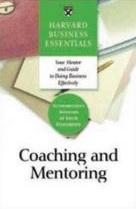Coaching and Mentoring subtitled, How to Develop Top Talent and Achieve Stringer Performance was published by HBS press as part of their guides to doing business effectively. Though not listed on the cover the book was actually written by Richard Luecke and the subject adviser is Herminia Ibarra.
The book is more of a practical guide to coaching and mentoring for managers, team leaders and supervisors who are working with their direct reports to improve performance. It is divided into two distinct parts, the first focusing on coaching and then the remainder mentoring. The book starts out with a detailed introduction which gives an overview of what you will read in the book delving into what each chapter contains.
Going into reading each chapter it feels really like a comfortable experience. Each chapter is prefaced with a page which lists the key topics that will be covered in the chapter. The language of the chapters are instructional, simple and straightforward and explained concepts are illustrated with short examples and stories. Each chapter also concludes with a section called 'Summing Up' which is a bullet point summary of what was covered in the chapter.
The book has a well laid out structure as described below:
- A table of contents
- An introduction
- 11 chapters
- Two appendices
- Notes
- Glossary
- Further reading
- Index
- Information about the subject adviser, author and Harvard Manage Mentor, Harvard Publishing's elearning programme for managers.
Here is a brief overview of each chapter.
- Chapter One - What Coaching Is All About: In this chapter you will read about what coaching is, benefits of coaching for managers and their employees and a four-step process for coaching. It also discusses how to identify opportunities for coaching and how to use performance appraisals to guide coaching.
- Chapter Two - Preparing to Coach: This chapter is mainly about identifying areas that may require coaching and how to do so through actions like observation, listening, testing the validity of an area that may require coaching and also being clear about whether coaching is the right approach for an issue identified. This is the first step of the four-step process for coaching.
- Chapter Three - Discussion: This is the second stage of the four-step coaching process and it emphasizes the manager having a discussion with the person about what they observed and also getting the person's perspective about the observation. Skills that will aid the manager having the discussion effectively are covered. These include asking probing questions, open-ended and closed questions, active listening and listening for emotions.
- Chapter Four - Active Coaching and Follow-Up: This covers the third and fourth steps of the four coaching steps. Some of the questions that the chapter answers are: How do you obtain agreement on goals, how to create an action plan, how to begin coaching, giving and encouraging feedback and adopting an appropriate approach.
- Chapter Five - Becoming a Better Coach: Coaching is not easy especially for managers who've not done it before, but you can certainly get better at it. Becoming a better coach is what this chapter is about. It tackles topics such as knowing when to coach and delegate, creating the right coaching climate and mistakes to avoid in order to become a better coach.
- Chapter Six - Executive Coaching: This chapter takes a break away from the other chapters to briefly describe executive coaching which is different from performance coaching discussed in the previous chapters. Why executive coaching? Two approaches to executive coaching and what to look for in an executive coach are some of the key topics covered.
- Chapter Seven - Mentoring and Management: This chapter begins the second part of the book focusing on mentoring. There are some interesting insights in this chapter as it highlights the differences between mentoring and coaching and the benefits of mentoring.
- Chapter Eight - The Right Match: How to match mentors to a protegees and the issues involved is discussed. There is also an example of a company using an online matching program for mentors and protegees.
- Chapter Nine - Being an Effective Mentor: The discussion in this chapter focuses on what is involved in being an effective mentor. Topics covered are characteristics of effective mentors, how to mentor well, and for proteges, how to make the most of mentoring.
- Chapter Ten - Women and Minorities: This chapter deals with the challenges women and minorities face where mentoring is concerned and how mentoring can work for them.
- Chapter Eleven - Beyond Traditional Mentoring: This last chapter looks at a different way to do mentoring - Peer Mentoring. On this topic learning from peers, when peer mentoring works best, benefits of a mentoring network and tips for creating a network of mentors is examined.
My own thoughts about this book is that it is an easy read and enjoyable too. It doesn't go too deep into the psychology of coaching but rather focuses on simple and practical coaching tips which are not difficult to understand. It is mostly aimed at those who manage people and want to improve performance. Here are some my main learning from the book:
- How the difference between coaching and mentoring is explained
- The four step coaching process
- The numerous stories that are used to explain concepts
- The layout of each chapter which first highlights each chapters lessons and concludes each chapter with a brief summary
- The brief information on executive coaching
- The treatment of peer mentoring
This book could be a good leadership development tool for managers, team leaders and supervisors interested in performance coaching with their team members. And I do think learning and development practitioners will certainly learn something from it.








